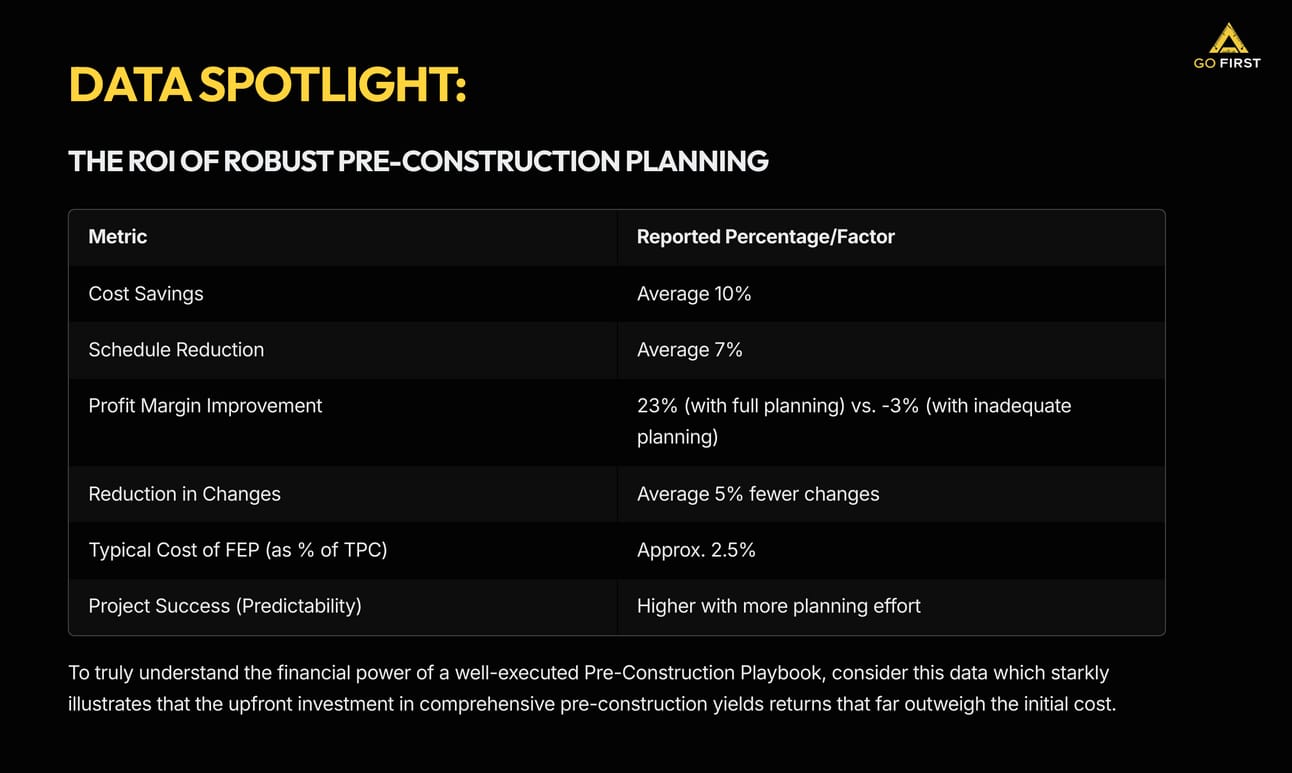TL;DR
(Too Long; Didn't Read)
Stop Firefighting, Start Strategizing: Your Pre-Construction Playbook is more than paperwork; it's a dynamic strategic framework that sets every project up for success by defining objectives, budgets, and quality standards before you break ground.
The ROI is Real: Investing in thorough pre-construction (around 2.5% of Total Project Cost) delivers an average 10% cost reduction, 7% schedule shortening, and can mean the difference between a 23% profit margin and a -3% loss.
It’s All Connected: Your project’s scope, budget, schedule, and risk management are deeply intertwined. Get one wrong, especially the initial client needs assessment, and the whole project can unravel.
Are you a builder or remodeler in the $1 million to $5 million revenue range feeling the constant pressure of operational chaos? Are you tired of projects that seem to veer off course, eating into your profits and timelines, despite your best efforts? If this sounds familiar, the single most powerful shift you can make isn't about working harder; it's about working smarter, right from the very beginning. We're talking about developing and diligently implementing a robust Pre-Construction Playbook.
Many builders hear "pre-construction" and think of a few quick checklists. But for established businesses looking to scale profitably, it’s so much more. It's your company’s strategic command center for every project, the system that transforms a client's vision into a predictable, profitable reality. In today's competitive market, where margins are tight and surprises are costly, a well-crafted Pre-Construction Playbook isn't a luxury – it's the bedrock of sustainable success.
Table of Contents

At GO First Consulting, we help remodelers and builders move beyond frustration and implement proactive, strategic approaches to estimates and sales. This article provides a playbook packed with creative and unconventional sales strategies specifically tailored to help you find and keep the projects your business depends on.
01. Beyond the Checklist:
What a Modern Pre-Construction Playbook Really Is
Let's be clear: a Pre-Construction Playbook, when done right, is far more than a static to-do list. It's a dynamic, strategic framework – an organizational asset that embodies your company’s accumulated knowledge, strategic intent, and capacity to adapt. [27, 21] It's the foundational work you undertake before a single hammer swings, defining clear project objectives, establishing realistic budget constraints, and setting unambiguous quality standards. [22] This critical phase bridges the gap between initial concepts and concrete, actionable plans, meticulously balancing cost-efficiency and quality while proactively identifying and mitigating potential risks. [22]
Think of it as evolving from traditional, often rigid and siloed pre-planning, to a modern, dynamic system. [36, 37] Historically, pre-construction was often a linear, document-heavy process with potential communication breakdowns and limited flexibility. [35] Today, your playbook needs to be different. It must incorporate iterative development, embrace sophisticated digital workflows (yes, even AI-enhanced insights where practical), and foster a much higher degree of interdisciplinary collaboration. [37, 919] It’s about shifting from reactive problem-solving during construction to proactive strategic optimization from day one. [39]
The challenge many builders face is that there isn't a universally formalized definition of a "pre-construction playbook." [25] This ambiguity can lead to ad-hoc development and inconsistent application, diminishing its strategic impact. [31, 33] But at its core, a powerful playbook provides a strategic, adaptable, and comprehensive guide for navigating the inherent uncertainties of every construction project, not just a sequence of steps. [24, 28]
A critical, yet often underestimated, factor in successfully implementing a modern playbook is your team's readiness for systemic change and technological adoption. [42] Tools like Building Information Modeling (BIM) and practical Artificial Intelligence (AI) applications for estimating or scheduling offer immense potential. [11, 919] However, their value is only realized with proper investment in training and a willingness to adapt processes. [43, 46] Without this, even the best playbook remains theory.
02. The Hard Numbers:
Why Excellence in Pre-Construction Pays (Massively)
Still think pre-construction is just an upfront cost? The data tells a powerful, profit-driven story. Investing in thorough, meticulously executed pre-construction planning – often called Front-End Planning (FEP) – yields significant, measurable returns that directly impact your bottom line. [47]
Research from the Construction Industry Institute (CII) is compelling:
Cost Reduction: Well-performed FEP can lead to an average 10% reduction in project costs. [49]
Schedule Shortening: Expect an average 7% reduction in project schedules. [49]
Fewer Changes: Projects see an average 5% decrease in the number of project changes – those profit-killing scope creeps. [49]
And what’s the typical investment for this kind of return? Around 2.5% of the Total Project Cost (TPC). [50]
But here’s the kicker, especially for builders focused on profitability: one landmark study highlighted in the Journal of Construction Engineering and Management found that projects with comprehensive pre-construction planning achieved an average profit margin of 23%. In stark contrast, those with inadequate pre-construction planning? They faced an average negative margin of -3%. [50] Let that sink in. That’s a 26-point swing directly attributable to the quality of your upfront planning.
This isn’t just about saving a bit here and there. It’s about fundamentally shifting your project outcomes towards greater predictability, significantly reduced risk, and ultimately, robust profitability. [52] The "Influence Curve" in project management clearly shows that your ability to positively impact project outcomes is highest – and the cost of making changes is lowest – during these early planning stages. [57] Your Pre-Construction Playbook is your tool to leverage that influence effectively.
03. Deconstructing Your Playbook:
The Indispensable Pillars for Success
So, what goes into a Pre-Construction Playbook that actually works for a $1M-$5M builder or remodeler? It’s built on several fundamental pillars, all deeply interconnected. [63, 75] Getting these right is critical:
01. Crystal Clear Scope & Objectives: This is job one. Clearly articulate the project's goals, deliverables, boundaries, and what success looks like. [67] A fuzzy scope is the fastest path to disaster.
02. Rock-Solid Budget & Cost Estimation: Determine the real financial resources required. This means detailed breakdowns for materials, labor, equipment, and – crucially – contingency. [68] No more guesstimates.
03. Realistic Timelines & Scheduling: Develop a practical project schedule with key milestones, task dependencies, and the overall duration. [69] Hope is not a strategy here.
04. Thorough Site Analysis & Feasibility: Investigate the site conditions, utilities, environmental factors, zoning, and overall project viability. [69] What you don’t know can hurt you.
05. Proactive Risk Assessment & Mitigation: Systematically identify potential risks (financial, operational, safety, schedule-related), analyze their impact, and develop mitigation strategies. [69] This isn’t just about a list; it’s about a plan.
06. Navigating Permits & Regulatory Compliance: Ensure adherence to all building codes, zoning laws, and secure necessary permits. [69] This is a critical path that can stop a project cold.
07. Assembling Your A-Team: Identify required roles and bring together a skilled team (including trusted subcontractors), fostering effective communication and collaboration. [69]
08. Coordinated Design Development: Transform conceptual designs into detailed, buildable plans, ensuring seamless coordination between all disciplines (architectural, structural, MEP). [70]
09. Strategic Resource Planning: Plan for the availability of your people, equipment, and materials for each stage. [70]
10. Proactive Stakeholder Communication: Establish clear communication lines and manage expectations for everyone involved (owners, designers, your team, key subs). [70]
11. Smart Technology Integration: Leverage the right tech – BIM for visualization and clash detection, project management software for organization, even practical AI tools for estimating or takeoffs – to enhance planning and collaboration. [71, 919]
12. Unwavering Quality Standards: Clearly define expectations for materials, workmanship, and the final product. [71]
The Unspoken Multiplier: Initial Client Needs Assessment Among these components, one often underemphasized element acts as a foundational multiplier: the quality of your initial understanding of client needs. [77] If client needs and project objectives are poorly defined, misinterpreted, or inadequately captured at the outset, the scope will be ambiguous. [78] This triggers a cascade of negative impacts: inaccurate estimates, flawed schedules, designs that miss the mark, costly rework, scope creep, and ultimately, an unhappy client – no matter how well you execute other parts of your playbook. [79, 80] Nailing this initial alignment is your highest leverage point.
These components aren’t isolated silos. A flaw in design coordination, for instance, directly impacts cost, schedule, and can lead to increased change orders. [85, 86] Similarly, delayed or inaccurate information flow between your design team and estimators creates bottlenecks and propagates errors. [93, 94] Your playbook must acknowledge and manage these interdependencies.
04. The Bottom Line
Ready to transform your pre-construction process from a liability into your greatest asset? Download Your Free Pre-Construction Playbook Checklist Here [Link] to start identifying the critical system components you need for predictable project success and profitability.
05. Appendix: Helpful Resources
Vision To Reality: Preconstruction Planning Playbook - Contractor Plus, accessed May 7, 2025, https://contractorplus.app/best-practices-for-preconstruction-planning/
The Preconstruction Phase: A Deep Dive into the Precon Process | Procore, accessed May 7, 2025, https://www.procore.com/library/preconstruction-phase
Custom Builders' Guide to Navigating IBS 2025 | Know The Show, accessed May 7, 2025, https://blog.buildersshow.com/2025/02/custom-builders-guide-to-navigating-ibs-2025/
The 2025 NAHB International Builders' Show®, accessed May 7, 2025, https://www.buildersshow.com/search-api/EducationEventPDF?year=2025
What Is Preconstruction Planning? Learn Benefits & Tips, accessed May 7, 2025, https://www.rib-software.com/en/blogs/preconstruction-planning







